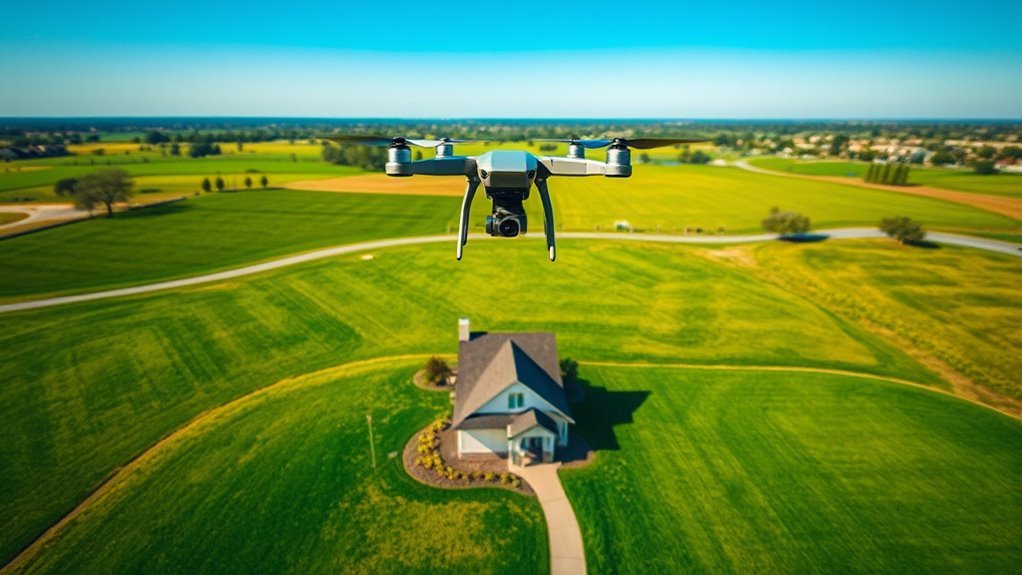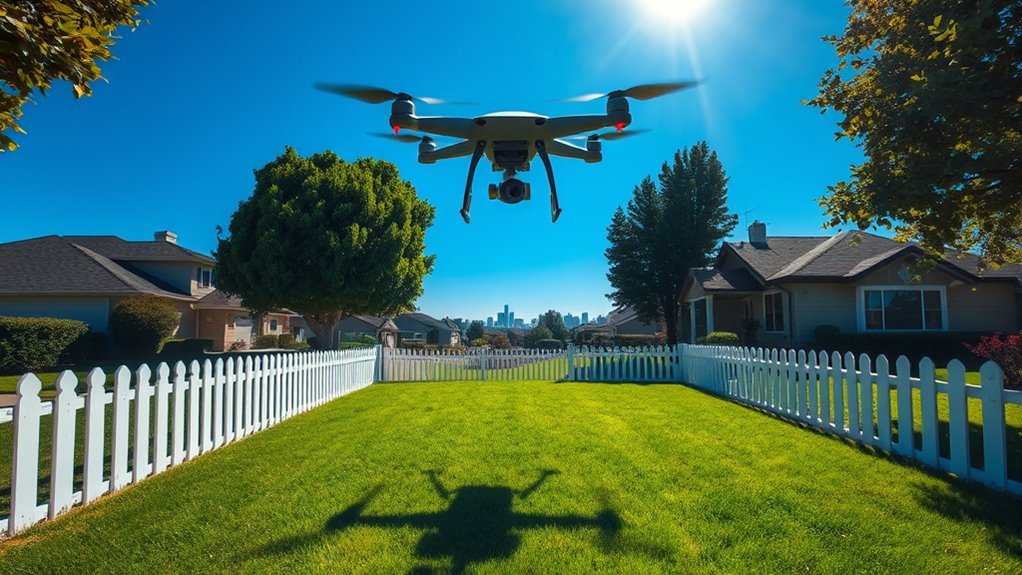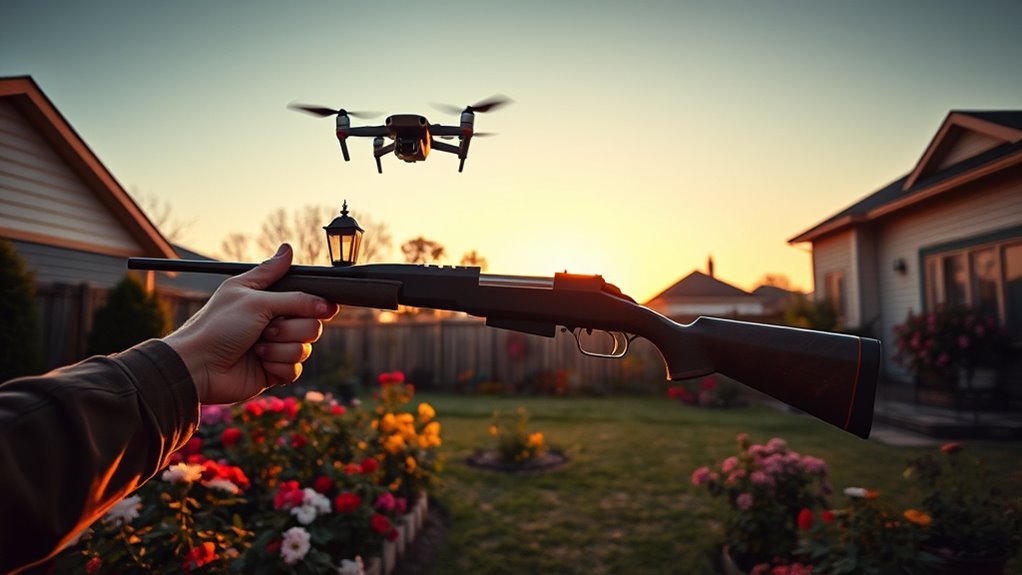Shooting drones over your property can lead to significant legal issues, including civil liability and potential criminal charges. Laws differ by state, but generally, discharging firearms in urban areas is heavily restricted. The FAA controls accessible airspace, which includes areas above private land, complicating the situation further. Instead of resorting to extreme measures, consider alternative solutions for dealing with intrusive drones. Understanding your rights and local regulations is essential for managing this complex issue.
Understanding Drone Regulations

Although flying a drone over your property might seem straightforward, understanding the regulations governing such actions is vital. First, you need to prioritize drone safety by familiarizing yourself with the Federal Aviation Administration (FAA) guidelines. These rules not only protect your rights but also guarantee the safety of others in the airspace. Airspace awareness is essential; different zones have specific regulations, and operating your drone in restricted areas could lead to significant penalties. You must also consider local laws, which may impose additional restrictions. For instance, in Nicaragua, drones must be operated within line-of-sight to ensure compliance with safety regulations. By staying informed about these regulations, you empower yourself to enjoy the freedom of drone operation while respecting the rights and safety of those around you. Additionally, be aware that federal government controls navigable airspace above personal property, which may affect your drone operations.
Property Rights and Airspace

When it comes to property rights, understanding airspace ownership is vital. While you may control the land beneath you, federal aviation regulations generally govern the airspace above. Additionally, local drone laws can further complicate what you can and can’t do with drones over your property.
Airspace Ownership Explained
While property ownership typically includes the land beneath your feet, airspace rights can be less straightforward. Understanding your airspace boundaries is essential for asserting your property rights. Here’s what you need to know:
- Airspace rights usually extend to a reasonable height above your property.
- Ownership doesn’t grant you absolute control over the airspace.
- Local laws may influence how far your rights extend.
- Drones may operate within navigable airspace regulated by federal authorities.
- Disputes can arise from encroachments or perceived invasions.
Knowing these aspects helps you navigate the complexities of airspace ownership while safeguarding your rights. By understanding these nuances, you can make informed decisions about drone interactions above your property.
Federal Aviation Regulations
As federal aviation regulations govern airspace use, understanding how they intersect with property rights is essential for drone owners and property holders alike. The Federal Aviation Administration (FAA) maintains authority over navigable airspace, which complicates airspace disputes between drone operators and property owners. You may feel entitled to protect your property, but these regulations can limit your options. For instance, drone enforcement by the FAA can penalize unauthorized flights, even if they occur above your land. This creates a delicate balance between exercising your rights and adhering to federal laws. Familiarizing yourself with these regulations not only helps you navigate potential conflicts but also empowers you to advocate for your interests while remaining compliant with the law.
Local Drone Laws
Maneuvering local drone laws is essential for understanding how property rights intersect with airspace usage. These laws vary greatly by region, impacting your ability to manage drone noise and privacy invasion on your property.
Consider the following:
- Local ordinances: Know the specific regulations in your area.
- Airspace rights: Understand how high above your property you have control.
- Drone usage: Differentiate between recreational and commercial drone activities.
- Noise complaints: Document any disturbances caused by drones.
- Privacy laws: Be aware of regulations concerning aerial surveillance and photography.
Legal Consequences of Shooting Drones

If you decide to shoot a drone hovering over your property, you could face serious legal repercussions. Engaging in such an act may expose you to civil liability, as the drone’s owner could sue you for damages. Additionally, shooting a drone could lead to criminal charges, depending on local laws and regulations. Firearms discharge laws vary considerably, and using a weapon, even in defense of your property, can result in severe penalties. You could be held accountable for reckless endangerment if your actions put others at risk. Understanding the legal landscape is essential before taking drastic measures against drones. Prioritize non-violent solutions, as the potential consequences often outweigh the perceived violation of your airspace.
The Role of the FAA
While many property owners may feel justified in taking action against drones over their land, it is crucial to recognize the Federal Aviation Administration’s (FAA) role in regulating airspace. The FAA enforces rules that govern drone operations, which can impact your rights.
- Airspace jurisdiction: The FAA controls navigable airspace, which includes your property.
- Drone registration: Operators must register drones for compliance with FAA regulations. Understanding the importance of drone insurance can also provide added protection for drone operators.
- Flight restrictions: Certain areas may have restrictions that affect drone flights, even above private land.
- Reporting violations: You can report unauthorized drone activity to the FAA for enforcement actions.
- Legal consequences: Violating FAA regulations can lead to severe penalties for drone operators. Additionally, it is important to be aware of privacy regulations that prohibit unauthorized data collection over private property.
Understanding these regulations can help you navigate your rights without resorting to drastic measures.
State Laws and Local Ordinances
Understanding the FAA’s regulations is just the beginning; state laws and local ordinances can impose additional restrictions on drone usage over private property. Many states have enacted specific regulations that dictate how and when drones can be operated, sometimes requiring permits or licenses. Local enforcement can further complicate matters, as municipalities may have their own rules regarding drone flights, including no-fly zones and privacy concerns. If you’re considering shooting a drone, you must be aware of these state regulations and local laws to avoid potential legal repercussions. Ignoring them could lead to fines or other penalties, infringing on your freedom and rights as a property owner. Always consult local statutes to guarantee compliance before taking any action. Additionally, it is crucial to understand that federal laws define navigable airspace and may override state regulations in certain situations.
Alternative Methods for Dealing With Drones
When faced with intrusive drones, there are several legal and practical alternatives you can explore. Utilizing drone detection systems can help you identify and monitor these devices, while noise and disruption techniques can deter them from invading your airspace. Understanding legal surveillance options will guarantee you stay within the bounds of the law while addressing the issue effectively.
Legal Surveillance Options
As you navigate the complexities of drone surveillance, it’s essential to evaluate legal alternatives that allow you to monitor aerial activity without infringing on privacy rights or local regulations. Here are some options to take into account:
- Use of surveillance technology that complies with local laws.
- Install cameras strategically positioned to capture aerial movements.
- Employ professional services that specialize in aerial monitoring.
- Engage local authorities to report unauthorized drone activity.
- Document incidents with timestamps and photos for potential legal action.
Drone Detection Systems
While traditional surveillance methods can provide some insights, investing in drone detection systems offers a more advanced approach to managing unauthorized aerial activity. These systems employ sophisticated drone detection technologies that can identify and track drones within your airspace, enhancing your security measures greatly. By integrating aerial surveillance systems with these detection technologies, you gain real-time alerts and thorough situational awareness, empowering you to take appropriate actions against potential intrusions. This proactive strategy not only helps protect your privacy but also preserves your rights in the face of increasing drone usage. Embracing these modern solutions allows you to maintain control over your property, ensuring you can enjoy your freedom without unwarranted interference from unauthorized drones.
Noise and Disruption Techniques
Noise and disruption techniques represent a viable alternative for managing drone incursions over private property. While some methods may inadvertently create noise pollution, others can effectively deter unwanted drones without escalating to harmful measures. Here are some strategies you might consider:
- Sound Emitters: Devices that produce high-frequency sounds to disturb drones.
- Laser Systems: Non-lethal lasers aimed to distract operators or disrupt flight patterns.
- Decoys: Creating visual distractions that draw drones away from your space.
- Signal Jammers: Disrupting communication between the drone and its operator (check legality).
- Physical Barriers: Installing netting or other structures to obstruct access.
These techniques aim to minimize disruptive behavior while protecting your freedom to enjoy your property unbothered by intrusive drones.
Privacy Concerns and Surveillance
How do privacy concerns intersect with the use of drones over private property? Drones equipped with cameras can lead to significant privacy invasion, raising questions about surveillance ethics. When these devices hover above your land, they can capture images and videos without your consent, potentially violating your right to privacy. This intrusion can create a chilling effect on your freedom, as you may feel constantly monitored. The balance between technological advancement and personal privacy is delicate; you deserve to enjoy your property without the worry of being surveilled. It’s essential to understand the implications of drone usage in your vicinity, ensuring that your rights are respected while steering through the evolving landscape of aerial technology and personal freedoms.
Seeking Legal Recourse and Mediation
If you’ve experienced drone activity infringing on your property rights, seeking legal recourse may be a viable option. Legal mediation can facilitate dispute resolution without escalating to court. Here are some steps to contemplate:
- Document Incidents: Keep detailed records of drone activity and its impact.
- Communicate: Attempt to resolve the issue directly with the drone operator.
- Consult Legal Experts: Seek advice from attorneys specializing in property law.
- File a Complaint: If direct communication fails, contemplate filing a formal complaint with local authorities.
- Explore Mediation Services: Utilize mediation services to reach an amicable agreement.
Frequently Asked Questions
Can I Use a Slingshot to Shoot Down a Drone?
Around 1.5 million drones operate in the U.S. Using a slingshot to shoot down a drone isn’t recommended; not only is slingshot effectiveness questionable, but drone safety laws could lead to serious legal consequences.
What if the Drone Is Flying at Night?
At night, drone visibility decreases, complicating identification. Nighttime regulations often restrict drone operations. You need to be aware of these laws to guarantee you’re acting within your rights while considering safety and privacy concerns.
Are There Specific Weapons Illegal for Shooting Drones?
You should know that certain weapons, like firearms and explosives, are illegal under drone regulations. Using these can lead to serious legal consequences, so it’s essential to understand the laws governing drone interactions in your area.
Can I Shoot a Drone if It Invades My Privacy?
Isn’t it frustrating when someone invades your privacy? While you might feel justified in reacting, drone laws often prohibit shooting them down, even in privacy invasion cases. Always consider legal repercussions before acting impulsively.
How to Report a Drone I Cannot Shoot Down?
If you can’t shoot down a drone, familiarize yourself with local drone regulations. Document the incident and follow reporting procedures, which often involve contacting law enforcement or aviation authorities to address potential privacy violations.

